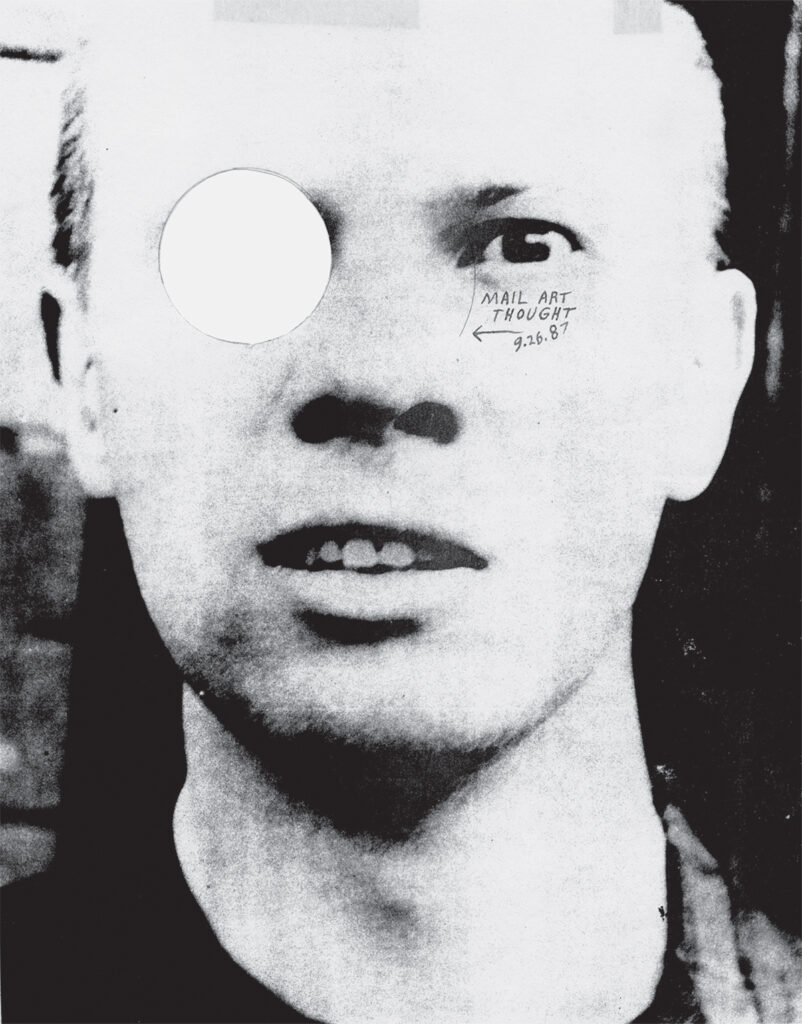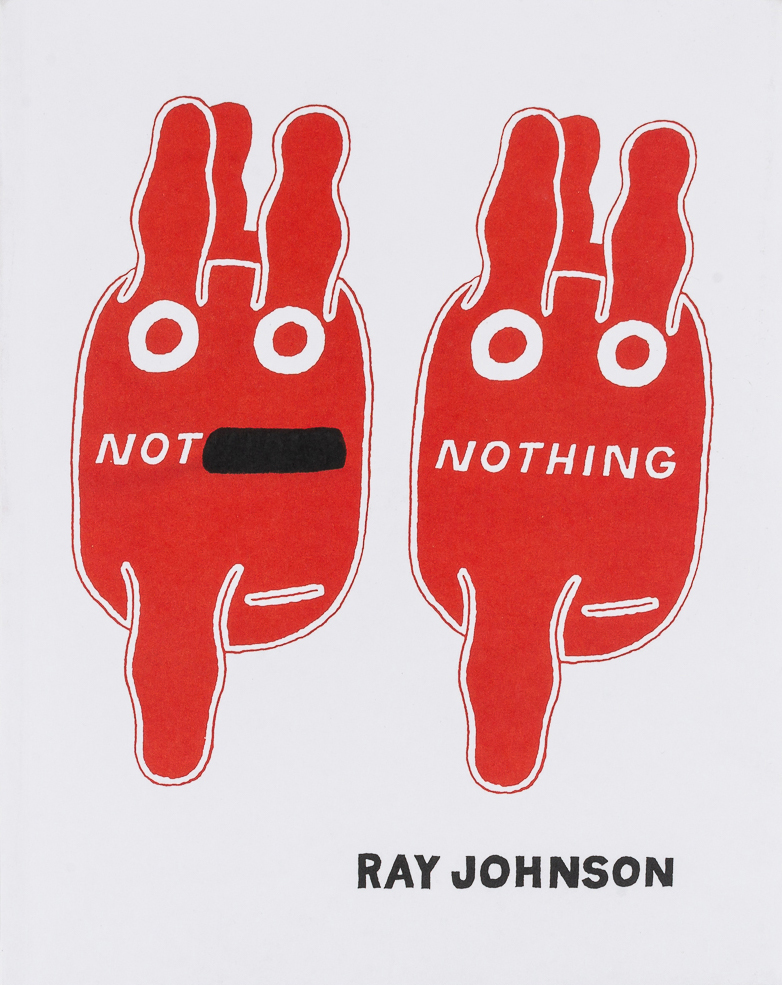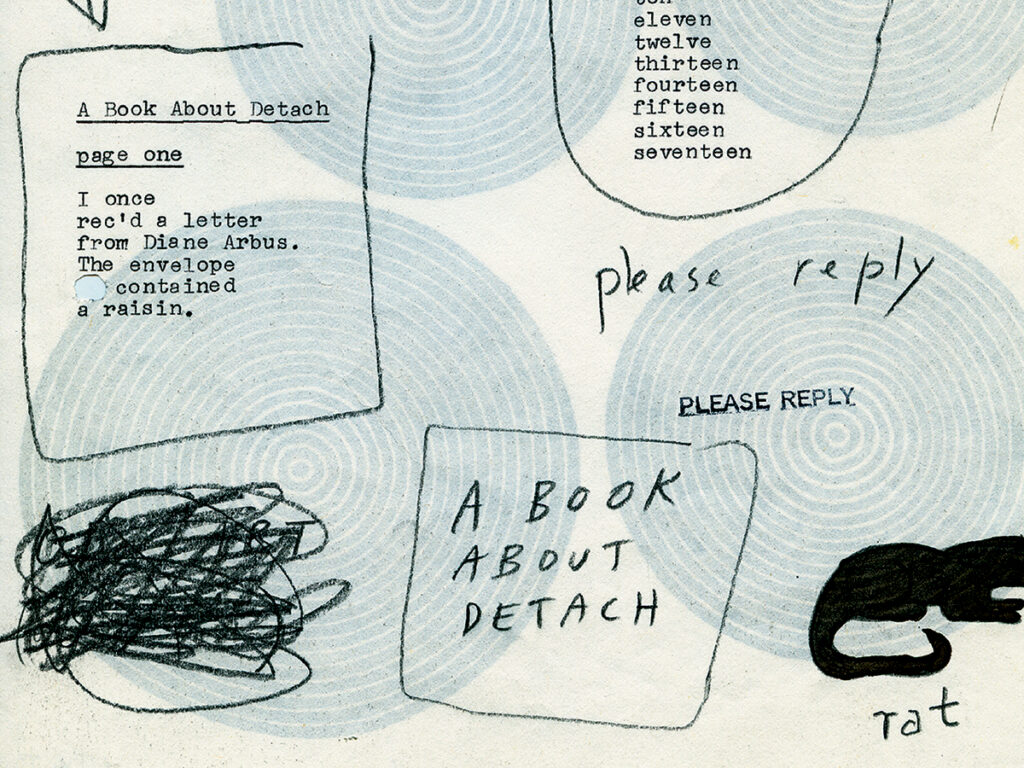Post ModernHow Ray Johnson’s Contrarian Sensibility Inspired Mail ArtAlbert Mobilio, Bookforum
reviews, 06/20/14
Originally published in Summer, 2014.
From our current vantage, it’s not hard to acknowledge that one of the presiding spirits of early-twenty-first-century art is Ray Johnson’s. Collagist, painter, poet, and the originator of mail art, Johnson took up the appropriative strategies of Marcel Duchamp and Jasper Johns, infused them with John Cage’s ideas about Zen and chance, and energized the mix with his own brand of deadpan Conceptualism. The art he made beginning in the early 1950s until his death in 1995 purposefully merged artist, artmaking, and art object in ways that were once disquieting but are now considered routine. The strong strain of performativity and self-reflexiveness—qualities that mark the work of artists such as Matt Freedman and Ryan Trecartin—was the animating force behind Johnson’s collages and texts and, more pointedly, what he chose to do with them. Rather than show in galleries, he mailed his work (often multiple Xeroxes) to hundreds of people, and encouraged them to embellish it and send it out again. The republication of his artist’s book The Paper Snake and the selection from his voluminous letters in Not Nothing are an opportunity to sample one of the most subversively witty intelligences to paste, draw, and type in the last half century.
A twenty-two-year-old Johnson arrived in New York in 1949 after studying at Black Mountain College, where he met, among others, Cage, Merce Cunningham, and Willem de Kooning; in the city he soon made contact with like-minded artists such as Johns, Cy Twombly, and Robert Rauschenberg. Within a few years, he knew everyone on the scene. No less ambitious than any of his contemporaries, Johnson nonetheless chose to work small—he began making collages on the 8 × 11″ cardboard sheets that came inside laundered shirts. He juxtaposed glamour shots of movie stars, advertisements, photos of writers, newspaper text, and images from physical-culture magazines in suggestive, slyly humorous ways that made clear there was a joke, but one so recondite that maybe only Johnson laughed.
Despite his art-world pedigree, or perhaps because of it, Johnson poked at the myth of the autonomous, heroic artist. One of his more famous pieces shows the Lucky Strike logo pasted onto an iconic photo of James Joyce; the ad hovers next to the author’s head, and he seems to be contemplating the bright red circle and its slogan, “It’s toasted,” with placid disdain. Another untitled piece from the series “The Luckies” sets two of the bull’s-eye logos on either side of the words “F. Scott Fitzgerald Crack-Up.” The recognizable names and images are put into dynamic play—one icon is set to playfully duel the other for visual dominance, even as a more covert tension animates the field of potential meaning: Is Johnson commenting on these writers’ careers, the haphazard distribution of fame, or the variable nature of aesthetic judgments?

Image from Not Nothing: Selected Writings by Ray Johnson, 1954–1994 courtesy of Richard L. Feigen & Co. and the Estate of Ray Johnson.
Johnson’s fascination with authors is no surprise given his own prodigious writerly proclivities. Not Nothing offers a small portion of his mail art—a conceptual project that remains his signal accomplishment. The process—one public yet intimate—by which Johnson put his collages and letters into circulation embodied his core aesthetic of motion and mutability. He dubbed his collages “moticos,” an anagram of osmotic, and thought of them as recombinations designed for further recombination—by him (he constantly altered his own work) and his correspondents. A sampling from a mail-art list titled “102 Moticos” from the early ’50s gives some sense of the deeply poetic, unsettling ambiguity of the notion: “machine for them,” “two pound one,” “Australian contemplating a ladder,” “the fan can name,” “bearer away,” “the Zebra feet girl,” and “used Switzerland.”None of these, or any of the other items, in any way define a moticos, and indeed they can each (and in aggregate) be regarded as antidefinitions. The move is characteristically Johnson’s—he also staged Zen-inspired events called “Nothings” in response to the ’60s vogue for Happenings.
This oppositional impulse guided Johnson’s approach to his letters, which are in fact metatexts, letters that parody and undermine not only the genre’s forms but the very notion of person-to-person communication. The New York Correspondance School (Johnson’s spelling) was the official-sounding name he gave to his postal round-robin; the moniker mocks the idea of artistic “schools” while alluding to actual correspondence schools, institutions that once offered high school degrees or certificates in, say, appliance repair. (The ritualized impersonality of sending homework back and forth between students and instructors no doubt intrigued Johnson.) His correspondents were artists and writers (Joseph Cornell, Christo, Marianne Moore, Andy Warhol, Lynda Benglis, James Rosenquist) who were teachers of sorts, providing him with inspiration (he asked to trace Moore’s tricorne hat; she declined) and encouragement.
A glance reveals that this is no ordinary collection of missives: Every page is distinct, as variations on collage, drawing, handwriting, and typography are all energetically exercised. Styles and forms also run the gamut; there are lists, poems, diary entries, koan-like tales, and annotations. Some are addressed to particular people, others aren’t addressed to anyone; some employ plain paper, others use loose-leaf, or stationery from hotels, businesses, and government offices. Johnson’s calibrated deployment of these elements demotes meaning in favor of the mode of presentation. The entirety of the mail-art experience—the use of the postal system, the process of opening an envelope, puzzling over the contents, the choice about whether to respond or discard—trumps the quaint idea that Johnson had something he wanted to say to someone …
Continue reading at Bookforum.com
see also
✼ natalie’s upstate weather report:
April 11, 2024 — The spring peepers have thawed (these little frogs freeze in winter) and now, unabashedly randy, they chirp. At first there was one, then two, and now it sounds like thousands. Two days ago, when it was truly spring, their adamantine chorus was almost deafening (we closed the windows to simply think!). Siglio has relocated to a lush, thriving hollow at the furthest most edge of the Berkshires after two years of peripatetics, sans library—which is now unpacked in a less than Benjaminian manner (little time to contemplate—our urgency in getting books on shelves mirrored the peepers need to mate). The first few months of 2024 were almost unendurable, but we’re home, spring is here, and there are books to made. We are singing!
[...]
